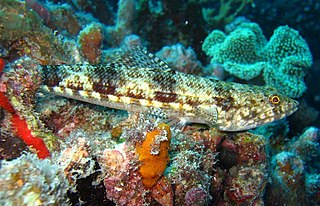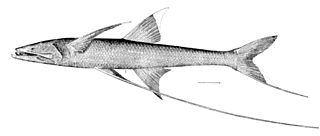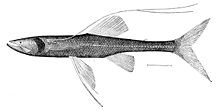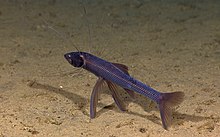
The Atlantic goliath grouper or itajara, also known as the jewfish, is a saltwater fish of the grouper family and one of the largest species of bony fish. The species can be found in the west ranging from northeastern Florida, south throughout the Gulf of Mexico and the Caribbean Sea, and along South America to Brazil. In the west Pacific it ranges from Mexico to Peru. In the east the species ranges in West Africa from Senegal to Cabinda. The species has been observed at depths ranging from 1 to 100 meters.

Aulopiformes is a diverse order of marine ray-finned fish consisting of some 15 extant and several prehistoric families with about 45 genera and over 230 species. The common names grinners, lizardfishes and allies, or aulopiforms are sometimes used for this group. The scientific name means "Aulopus-shaped", from Aulopus + the standard fish order suffix "-formes". It ultimately derives from Ancient Greek aulós + Latin forma, the former in reference to the elongated shape of many aulopiforms.

Grenadiers or rattails are generally large, brown to black gadiform marine fish of the subfamily Macrourinae, the largest subfamily of the family Macrouridae. Found at great depths from the Arctic to Antarctic, members of this subfamily are amongst the most abundant of the deep-sea fish.

The Cyclopteridae are a family of marine fishes, commonly known as lumpsuckers or lumpfish, in the order Scorpaeniformes. They are found in the cold waters of the Arctic, North Atlantic, and North Pacific oceans. The greatest number of species are found in the North Pacific. The family name Cyclopteridae derives from the Greek words κύκλος (kyklos), meaning "circle", and πτέρυξ (pteryx), meaning "wing" or "fin", in reference to the circle-shaped pectoral fins of most of the fish in this family.

The tripodfish or tripod spiderfish, Bathypterois grallator, is a deep-sea benthic fish in the family Ipnopidae found at lower latitudes. It is now relatively well known from photographs and submersible observations, and seems to prefer to perch on the ooze using much elongated fin rays in the tail and two pelvic fins to stand, facing upstream with the pectoral fins turned forward so the outthrust projecting fin rays resemble multiple antennae, and are indeed used as tactile organs. B. grallator is hermaphroditic. At least 18 species are placed in the genus Bathypterois, several of which have similar appearance and behavior to B. grallator. B. grallator is the largest member of its genus, commonly exceeding a standard length of 30 cm (12 in) and reaching up to 43.4 cm (17.1 in).

The Atlantic horse mackerel, also known as the European horse mackerel or common scad, is a species of jack mackerel in the family Carangidae, the jacks, pompanos and trevallies. It is found in the eastern Atlantic Ocean off Europe and Africa and into the south-eastern Indian Ocean. It is an important species in commercial fisheries and is listed as a Vulnerable species on The IUCN Red List of Threatened Species.

The Ipnopidae are a family of fishes in the order Aulopiformes. They are small, slender fishes, with maximum length ranging from about 10 to 40 cm. They are found in temperate and tropical deep waters of the Atlantic, Indian, and Pacific Oceans.

The snowy grouper is a species of marine ray-finned fish, a grouper from the subfamily Epinephelinae which is part of the family Serranidae, which also includes the anthias and sea basses. It is found in the western Atlantic Ocean.

The Gulf grouper is a species of marine ray-finned fish, a grouper from the subfamily Epinephelinae which is part of the family Serranidae, which also includes the anthias and sea basses. It is endemic to Mexico.

The rainbow runner, also known as the rainbow yellowtail, Spanish jack and Hawaiian salmon, is a common species of pelagic marine fish of the jack family, Carangidae. The species is widespread throughout the tropical and subtropical waters of the world, inhabiting both coastal and offshore areas. The species is the only member of the genus Elagatis, which was created 15 years after its initial description, and is closely related to the amberjacks. The rainbow runner is easily distinguished by its body shape, and the brilliant colouration which gives the fish its name. It is a fast-swimming predator, taking small fish, cephalopods, and a wide variety of planktonic crustaceans. The species reaches sexual maturity around 60 cm (24 in), and spawning takes place at different times, with some populations spawning year round, while others only spawn at certain times of the year. The species is a well known game fish, taken by a variety of fishing methods, and is a well-regarded table fish. Large numbers of the species are taken as bycatch in tuna- and shark-fishing operations and marketed.

Ipnops is a genus of deep-sea fish in the family Ipnopidae, which also includes the better-known tripodfish. Ipnops are small, slender fish that live close to the ocean floor in the bathyal and abyssal zones. The genus is notable for its unusual eyes.

The king threadfin, also known as the blind salmon, blink tassel-fish, burnett salmon, gold threadfin, king salmon, kingfish, Sheridan threadfin, triped tassel fish, or threadfin salmon, is a species of marine ray-finned fish, a threadfin from the family Polynemidae which is found in southern New Guinea and northern Australia.

The dog snapper, also known as the dogtooth snapper, pargue or snuggletooth snapper, is a species of marine ray-finned fish, a snapper belonging to the family Lutjanidae. It is native to the Atlantic Ocean. It is a commercially important species, and is popular for display in public aquaria.

The smooth lumpfish is a species of lumpfish native to the North Pacific where it is found at depths down to 1,700 metres (5,600 ft). This species grows to a length of 41 centimetres (16 in) TL. It is the only known member of its genus.
Anatoly Petrovich Andriyashev was a Soviet and Russian ichthyologist, marine biologist, and zoogeographist, notable for his studies of marine fauna of the Arctic and the Northern Pacific.

Chaenodraco wilsoni, the spiny icefish, is a species of marine ray-finned fish belonging to the family Channichthyidae, the crocodile icefishes. It is native to the Southern Ocean. This species is the only known member of its genus. It is of minor interest to commercial fisheries.

Anthias anthias, the swallowtail sea perch or marine goldfish, is a species of marine ray-finned fish from the grouper and sea bass family Serranidae. It is native to the eastern Atlantic Ocean and the Mediterranean Sea where it is associated with reefs. It is found in the aquarium trade.

Ipnops meadi, also known as the grideye fish, is a highly specialized species of Placodithyran abyssal fish found in the Clarion-Clipperton Zone of the Indo-Pacific Ocean. The species was named after Giles W. Mead of the Harvard Museum of Comparative Zoology, a biology professor at Harvard, deep sea explorer, and ichthyologist.

Congrogadinae is a subfamily of ray-finned fishes, one of four subfamilies that make up the family Pseudochromidae, these elongated fish are commonly called eel-blennies.
The radiated shanny is a species of marine ray-finned fish belonging to the family Stichaeidae, the pricklebacks and shannies. It is the only species in the monotypic genus Ulvaria. This fish is found in the northwestern Atlantic Ocean.
























